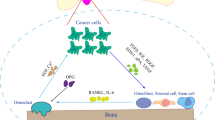Abstract
The majority of men with progressive prostate cancer develop metastases with the skeleton being the most prevalent metastatic site. Unlike many other tumors that metastasize to bone and form osteolytic lesions, prostate carcinomas form osteoblastic lesions. However, histological evaluation of these lesions reveals the presence of underlying osteoclastic activity. These lesions are painful, resulting in diminished quality of life of the patient. There is emerging evidence that prostate carcinomas establish and thrive in the skeleton due to cross-talk between the bone microenvironment and tumor cells. Bone provides chemotactic factors, adhesion factors, and growth factors that allow the prostate carcinoma cells to target and proliferate in the skeleton. The prostate carcinoma cells reciprocate through production of osteoblastic and osteolytic factors that modulate bone remodeling. The prostate carcinoma-induced osteolysis promotes release of the many growth factors within the bone extracellular matrix thus further enhancing the progression of the metastases. This review focuses on the interaction between the bone and the prostate carcinoma cells that allow for development and progression of prostate carcinoma skeletal metastases.
Similar content being viewed by others
Author information
Authors and Affiliations
Rights and permissions
About this article
Cite this article
Keller, E.T., Zhang, J., Cooper, C.R. et al. Prostate Carcinoma Skeletal Metastases: Cross-talk between Tumor and Bone. Cancer Metastasis Rev 20, 333–349 (2001). https://doi.org/10.1023/A:1015599831232
Issue Date:
DOI: https://doi.org/10.1023/A:1015599831232




